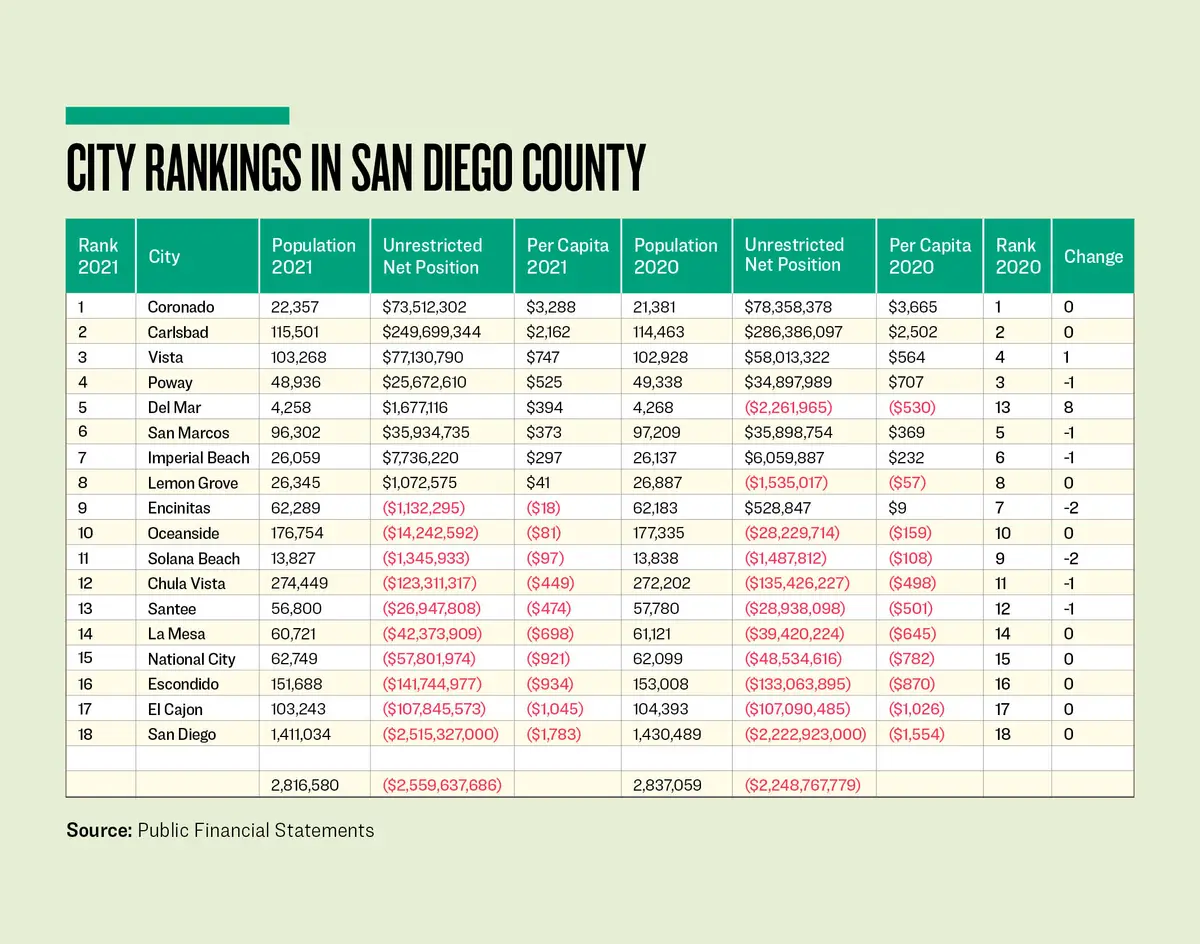Can City Budgets Be Tightened Up, or Should Taxpayers Pay More?
The fiscal year ending June 30, 2021, also saw the county’s population decline by 0.7 percent, reflecting the recent out-migration of California residents to other states.
It was a tough year for half of the county’s cities, while the other half improved their fiscal positions.
But the big news from the chart below is the continuing growth of the city of San Diego’s unrestricted net deficit. It grew by 13 percent during the fiscal year, reaching the $2.5 billion-dollar mark.

The cause lies in two areas. Its expenditures exceeded revenues by $171 million, surpassing the 2020 loss by $13.3 million. But San Diego grew its unrestricted net deficit by another $292 million, thanks mostly to pension liabilities growing by $720 million.
It reminds me of when the city was given the moniker “Enron-By-The-Sea” nearly a quarter-century ago. It was a reference to a publicly traded company that had imploded and became a very public example of the lack of proper disclosure. At least now San Diego is providing the details in their ACFR.
The dirty little secret about UAALs is that they have been kept artificially low over the decades by the actuarial assumption about what the pension system will achieve in investment returns. Having a high assumed rate of return means that the UAAL will be lower. This is a tactic that public employee unions have emphasized in order to continue advocating for higher salaries for their members. It works effectively when the elected leaders of a city are put into their positions through the financial influence of these same unions. When unions control the city councils, sad fiscal ramifications occur.
The results are fiscally catastrophic. When the investment return assumption is reduced, then the UAAL increases. When the UAAL increases, then the annual required contributions to the pension plan increase. When annual required contributions to the pension plan increase, it crowds out other necessary city expenditures, like salaries and pay increases. When salaries aren’t increased, then the public employee unions demand the city council put a measure on the ballot that increases sales taxes.
Since management is also not receiving salary increases, they go along with this knee-jerk solution, and city council members find unanimous internal support for a sales tax rate increase. Nearly one-third of San Diego County’s cities are currently discussing more taxes, when they should be discussing how to reduce the root causes of the growing UAALs.
Of the county’s 18 cities, half charge the minimum sales tax rate of 7.75 percent. Three cities, El Cajon, Oceanside, and Vista, have already raised their rates by a half-cent and charge 8.25 percent. La Mesa charges 8.50 percent. And five cities have already raised their rates by 1 cent, to 8.75 percent. These cities are Chula Vista, Del Mar, Imperial Beach, National City, and Solano Beach.
If someone purchases $10,000 in new furniture in the city of San Diego, the sales tax will be $775. If they purchase it in Del Mar, the sales tax will be $875. This may not sound like a substantial difference, but these are interesting times in a fiscally mismanaged state.
Since California’s annual budgets over the decades did not set adequate funds aside for proper road repairs, the supermajority in Sacramento raised your gas tax. Never mind that Caltrans is one of the worst running departments of transportation in the nation, and other fat-trimming should have been pursued first. Taxpayers with gas-powered vehicles had to take the hit.
The litany of small increases in other areas are also taking a toll. Since residents were successful in reducing their water usage, their water rates went up. The joys of less water sales requiring higher rates to maintain revenue levels. Now the electric utilities are in the same boat. More residents using solar panels means less purchases of electricity. So they have convinced Sacramento to raise the rates. Trash haulers want more. Fast-food restaurants are charging more thanks to Sacramento’s supermajority and Governor Newsom raising this industry’s minimum wage. It’s like water torture on your monthly budget.
Why can’t more cities be like Coronado? Half of the county’s cities would be in the positive side of the graph, had not Encinitas reduced its unrestricted net position by $1.7 million.
The city of Del Mar jumped back into the positive camp during the year. It received $3.5 million in sales and use tax during the fiscal year ending June 30, 2021, or 16.5 percent of all of its revenues for the year. One must wonder if the taxable sales of some $172.7 million would have been higher if the sales tax rate there was lower.
The city of Vista enjoyed $17.9 million in revenues in excess of expenditures, explaining the $19 million improvement in its unrestricted net position and why it leap-frogged the city of Poway.
The stories seem to be similar. Cities that have made extravagant financial promises to their powerful public employee unions are bearing the brunt of liabilities that this acquiescence made to their balance sheets. Pursuing negotiations with these unions, to modify their pensions and other post-employment benefit plans, should be on the table, especially when sales tax increase proposals are being encouraged. That is the joy of negotiating and giving up something to get more immediate financial rewards.
But when public employee unions are running a “gravy train” city, its residents will be left taking the hit on their personal household budgets. Don’t you wish your elected officials would treat your tax dollars the same way you do? Why should you be the crutch for their poor fiscal management?
This article originally appeared in The Epoch Times
